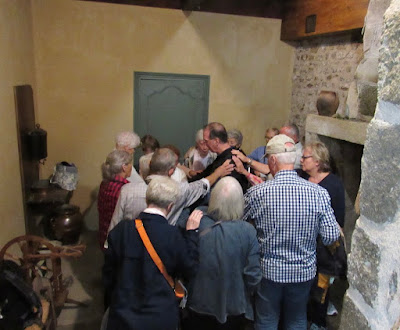The International Centre celebrated 20 years of service to the hundreds of people each year who make pilgrimages to the city where the first six sisters and Fr. Médaille founded the Sisters of St. Joseph in 1650. Many members of the team that created the Centre were present as well as those who today support the Centre and its programs and pilgrimages. The First Team of sisters who prepared the building were also on hand for the celebration.
Sr. Sheila Holly, a member of the First Team at the Centre, reunites with Janine Rocher, a neighbor who was there at the beginning. Janine's husband (deceased) provided the many repairs needed for renovation of the building.

Sr. Simone Saugues (Institute St. Joseph) goes over the final script for French-English translation with Sr. Eluiza de Andrade (Sao Paulo, Brazil), member of the Centre staff. Sr. Simone has been a translator, interpreter of French culture, and friend of various staff members since the Centre's beginning. Sr. Catherine Frommager (Lyon) is behind the two sisters. She was on the original Board of the Centre and contributed much to the renovation of the building.
Sr. Maryellen Kane (Brentwood, USA), president of the Centre Board, served as the emcee for the program. The program included a short talk about the formation of the Centre by Sr. Catherine Barrange, former superior general of the Lyon Congregation as well as a greeting by Daniel Joubert, mayor of Aiguilhe, and Vicar General Emmanuel Dursapt from the Diocese of Le Puy. The prayer service was prepared by the First Team of the Centre. To see the prayer service, click on the following languages: French, English, Spanish, Italian, and Portuguese.

Sr. Colette (Lyon), Sr. Lucia (Italian Federation), and Sr. Celine (Chambéry) help to transform the dining room.


Sr. Elsa Maria Nóbile (Argentina), brought a gift to the Centre representing the love of God with beauty and eternity. She is a member of the Global Coordinating Group (GCG). The GCG was on hand for its meetings that took place after the anniversary celebration. The Centre Board had its meetings before the event.

 Sr. Barbara Bozak (Chambéry) and Sr. Marie Paul Rascle, former superior general of the Institute St. Joseph, were both among those who helped create the Centre. Previously, the building was a home for the Institute's retired sisters. It had lain empty for 10 years and needed to be cleaned, renovated, and updated for use as the new International Centre for programs and pilgrimages.
Sr. Barbara Bozak (Chambéry) and Sr. Marie Paul Rascle, former superior general of the Institute St. Joseph, were both among those who helped create the Centre. Previously, the building was a home for the Institute's retired sisters. It had lain empty for 10 years and needed to be cleaned, renovated, and updated for use as the new International Centre for programs and pilgrimages.
(left to right) Sr. Elisabeth (Annecy), Sr. Lanto Razanajatovo (Aoste-Madagascar), and Sr. Jona Chinnappan
(Chambéry). Sr. Celine Kalathoor (Chambéry), Sr. Lucia Gallo (Cuneo, Italy) and Mme. Carole Umana (Canadian Federation).
Food offerings both delight the palate and beautify the table





Sr. Marie Louise Vulliez (Annecy), one of the original Board members, cuts the anniversary cake.

















































